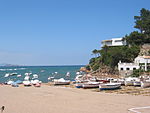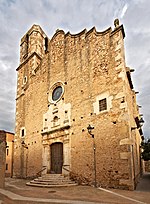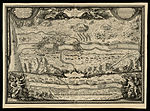Costa Brava

The Costa Brava (Catalan: [ˈkɔstə ˈβɾaβə]; Spanish: [ˈkosta ˈβɾaβa]; "Wild Coast" or "Rough Coast") is a coastal region of Catalonia in northeastern Spain. Sources differ on the exact definition of the Costa Brava. Usually it can be regarded as stretching from the town of Blanes, 60 km (37 mi) northeast of Barcelona, to the French border – in other words it consists of the coast of the province of Girona. In the 1950s, the Costa Brava was identified by the Spanish government and local entrepreneurs as being suitable for substantial development as a holiday destination, mainly for package holiday tourists from Europe. The combination of a very good summer climate, nature, excellent beaches and a favourable foreign exchange rate (before the creation of the single European currency), which made the Costa Brava an attractive tourist destination, was exploited by the construction of large numbers of hotels and apartments in such seaside resorts as Blanes, Tossa de Mar and Lloret de Mar. Tourism rapidly took over from fishing as the principal business of the area.
Excerpt from the Wikipedia article Costa Brava (License: CC BY-SA 3.0, Authors, Images).Costa Brava
Geographical coordinates (GPS) Address Nearby Places Show on map
Geographical coordinates (GPS)
| Latitude | Longitude |
|---|---|
| N 42.0228 ° | E 3.22449 ° |
Address
España
Spain
Open on Google Maps










